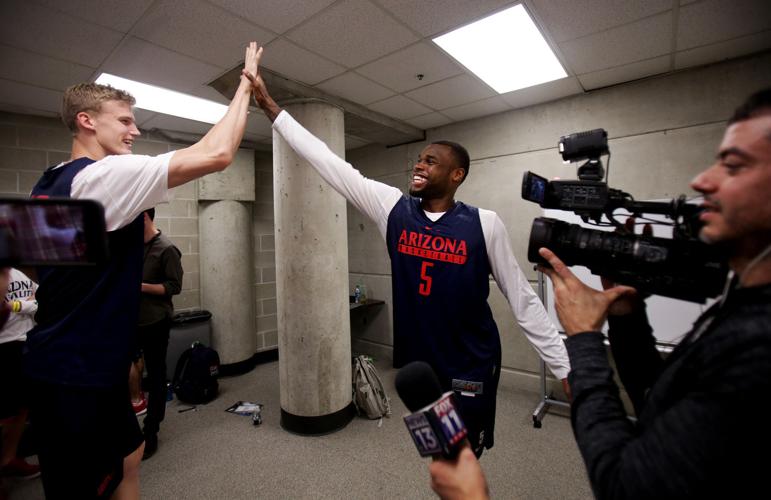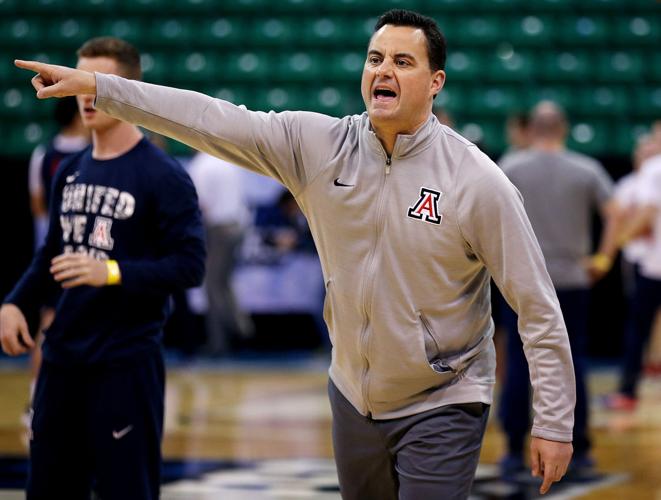SALT LAKE CITY – Once the Arizona Wildcats bused up the hill to Utah’s campus Wednesday afternoon, then planted their sneakers on the Pac-12 logos on the floor of the Utes’ sparkling $36 million practice facility, they knew.
This is the place. For them, too.
Utah. Their home away from home in early NCAA Tournament games, a regular conference stop and a place where they have lately found success.
Sure there was that first-round shocker way back in 1993, when Steve Nash’s 15th-seeded Santa Clara Broncos famously knocked off Arizona, and a second-round loss to Wisconsin in 2000.
But since then, the Wildcats beat Gonzaga in a second-round, double-overtime thriller in 2003 and made a somewhat surprising run to the 2013 Sweet 16 by winning a pair of games in the Utah Jazz’s home arena.
The UA is also 4-1 in conference games at Utah since the Utes joined the Pac-12 in 2011-12, though the two didn’t meet here this season because of the conference’s unbalanced schedule.
The Wildcats always stay in downtown Salt Lake City, they’re used to making slight adjustments to the high altitude, and they’re only about 600 miles away from home by air.
Compare that to last March, when Arizona was forced to fly all the way across the country, land in the cold and rainy weather of Providence, Rhode Island — and get rolled out of an arena named after a doughnut shop in their first game.
“I didn’t like that trip to Providence,” UA assistant coach Book Richardson said. “How the charter was set up and everything, there’s a lot that goes into it. We’ve been very fortunate to be able to get on a flight that’s an hour and a half and have the support of our fans.”
UA coach Sean Miller said he was grateful for the difference, but also indicated he felt somewhat deserving. After all, the UA was given the No. 2 seed in the West Region and a right to stay in the West for games in Salt Lake and (with two wins there) in San Jose, California, after going 30-4 and winning the Pac-12 Tournament last weekend in Las Vegas.
“You earn your seed. You earn your location,” Miller said. “And I’m sure that the play of our entire season, what happened this past weekend, allowed us to be here in Salt Lake City and have a seed like No. 2.
“We love being here in Salt Lake. It’s in the footprint of the Pac-12. Our players have been to this city many times. Our fans are able to travel here very easily and we’re here in an hour and a half, which a lot of teams in the tournament don’t have that. Now it’s up to us to take advantage and perform well.”
But there’s also this about Thursday’s game: For North Dakota, Utah is also a fitting place for its first NCAA Division I NCAA Tournament game ever.
The Fighting Hawks — who were known as the Fighting Sioux until 2012 — play all over the Rocky Mountain states as a member of the Big Sky Conference. They know long travel, and they know altitude.
They had to leave their home in Grand Forks, North Dakota, this season for conference games in Missoula, Montana; Pocatello, Idaho; Ogden, Utah; and Greeley, Colorado. Trips that take so long coach Brian Jones says his team is “the Hawaii” of its peers.
“But it’s no beaches and not a lot of water,” Jones said.
Last week, the Fighting Hawks went to the high desert of Reno and captured the Big Sky Tournament by winning three games in three days — then took a trip home on Sunday that was so long and weather-delayed that just as they pulled off the ground for their final leg home, they were barely able to catch a web stream telling them that they would be playing Arizona next.
So for them, coming to Salt Lake City on a charter flight was cake.
“It’s usually 12-hour (travel) days,” Jones said. “That’s why getting on this charter flight here, we were a fish out of water. A direct flight somewhere and it took two hours?”
There’s also this: The Hawks have played more games in the state of Utah than any other outside North Dakota since joining Division I — and they’re 11-11 over those games, including a 6-2 mark in neutral-site games. This season, they won at Southern Utah and Weber State, too.
Through that process, Jones has tried to help get comfortable with the altitude, too.
“We’ll do some drills and make them run some sprints just to shock the system,” Jones said. “It does take time. But I try to get to my bench early in the game because it does zap you. But we just played in altitude last week and been doing it all season so it’s not as much of a jump.”
Maybe adrenaline helps, too.
“Throughout this winning streak we’ve been on, we haven’t done anything extra,” North Dakota forward Drick Bernstine said. “The altitude doesn’t really affect us. We run at the same pace.”
Then again, maybe experience in the mountains doesn’t matter all that much.
New Yorker Rawle Alkins has never been to Utah before and, after testing out his lungs at the Utes’ practice facility Wednesday, the UA freshman said he noticed no difference in the altitude.
But he did notice something else.
He was comfortable.
“This is an amazing city, and the Utah Jazz play in this building,” he said at Vivint Smart Home Arena. “That’s amazing.”





